Here’s A German Plum Cake Recipe to Make a Classic Seasonal Dessert!
If you’ve got fresh plums and a little bit of motivation, German plum cake has got to be on your list of recipes to try.
Relatively easy to make, this delicious cake – known in German as Pflaumenkuchen, Zwetschgenkuchen, or Zwetschgendatschi – is a classic cake that is often enjoyed with coffee during “Kaffee und Kuchen” when plums are in season.
The fresh plums with their sweet and tart flavors, complement the soft, yeasty dough – and everything is topped with those classic streusel crumbs that everyone loves!
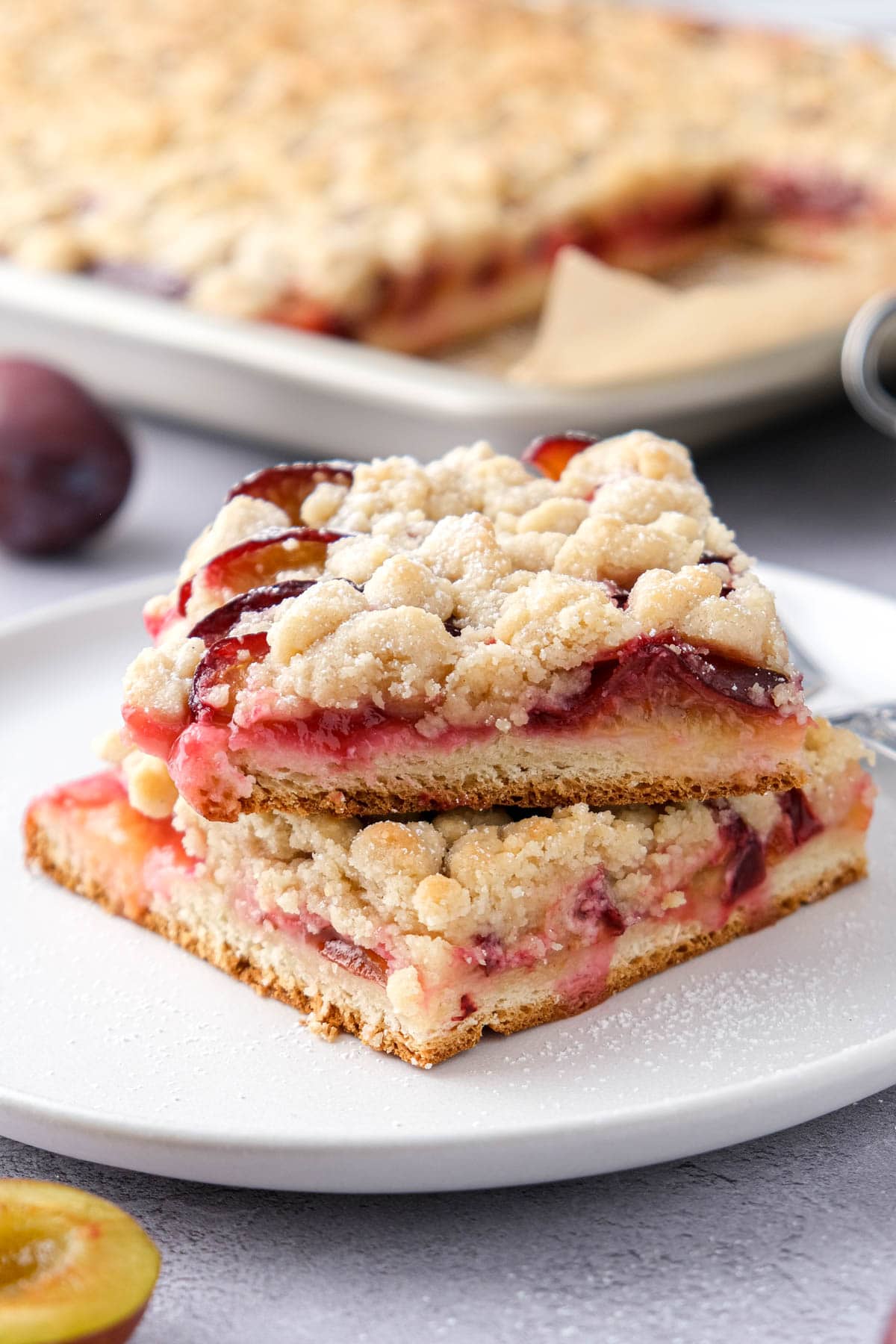
There are several ways to make this classic cake. You can make it with a yeast dough, shortcrust pastry or a simple “Rührteig”. You can also bake it on a baking sheet or in a springform pan.
This recipe shows you how to make a classic plum cake with yeast dough on a baking sheet. And of course, it has streusel.
Lisa grew up eating this version of plum cake at her grandma’s house, and it’ll always be one of her favorite German cakes.
Ingredients
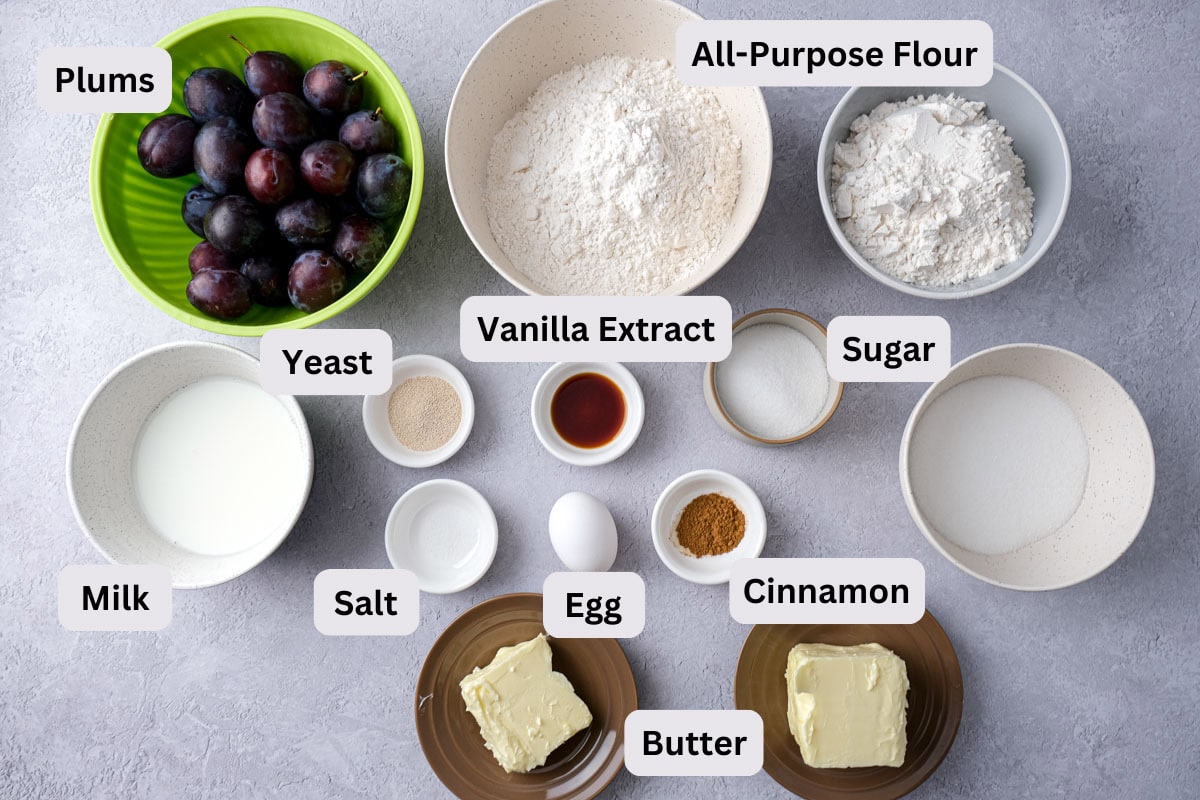
If you want to make this German plum cake with streusel, here are the ingredients that you will need!
- Plums – Any type of plum will work, but traditionally it is made with Italian prune plums, also called blue plums (which is what we used).
- Flour – Regular all-purpose flour to make the dough.
- Butter – Unsalted butter; it needs to be at room temperature. Some for the dough, some for the streusel.
- Granulated sugar – To make the dough and the streusel topping.
- Yeast – We use instant dry yeast. You can use active dry yeast, but be sure to dissolve it first.
- Egg – One large egg; must be at room temperature.
- Vanilla Extract – Alternatively you can use a package of vanilla sugar if you have it on hand.
- Salt – A pinch of salt.
- Ground cinnamon – Optional addition for the streusel topping.
Recipe Tips and Substitutions
Before you make this Pflaumenkuchen recipe, have a good read through these recipe tips so that you know just what to expect when you’re baking!
- Use plums that are ripe but not too soft. If the plums you’re using are very juicy, you can sprinkle some unseasoned breadcrumbs on the dough before placing the plums on top.
- You can also make this cake with other stone fruits, such as peaches, nectarines, or apricots.
- We’re using a yeast dough (called Hefeteig in German) in this recipe, but you can also make plum cake with Mürbeteig (shortcrust pastry) or a simple Rührteig.
- Since we’re using yeast, it’s important that the egg and butter are at room temperature. The milk needs to be warm, but not hot.
- Make sure the yeast you’re using hasn’t expired so the dough will rise.
- If you’re not a fan of the streusel topping, you can skip it or add slivered almonds instead.
- The exact baking time can vary depending on your oven and the size of the cake.
How to Make German Plum Cake – Step by Step Instructions
In this section, we’ll show you exactly how to make this easy German plum cake. We have included all the recipe process photos so that you can visually follow along as you bake at home.
Of course, the printable recipe card with the exact measurements and steps is located at the bottom of this post!
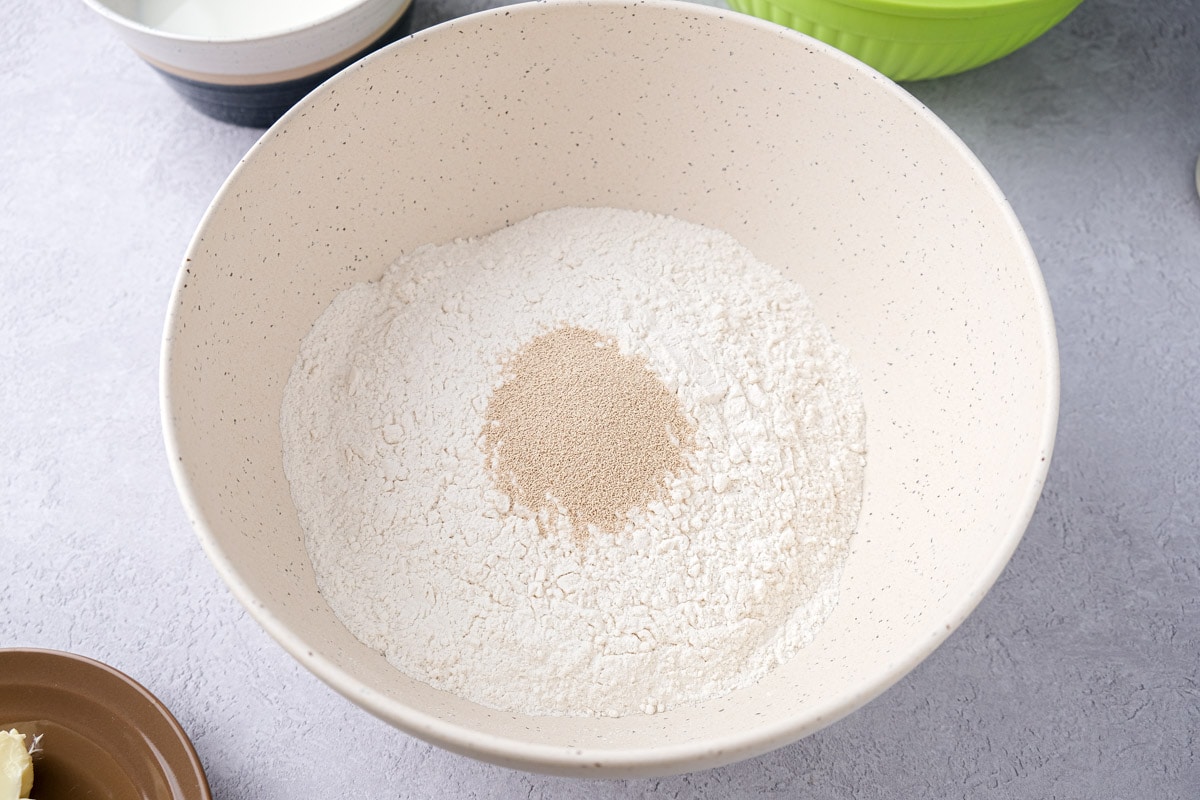
In a large mixing bowl, whisk together the flour and instant dry yeast.
If you’re using active dry yeast instead, dissolve it in some of the milk with a little sugar first (follow the package directions).
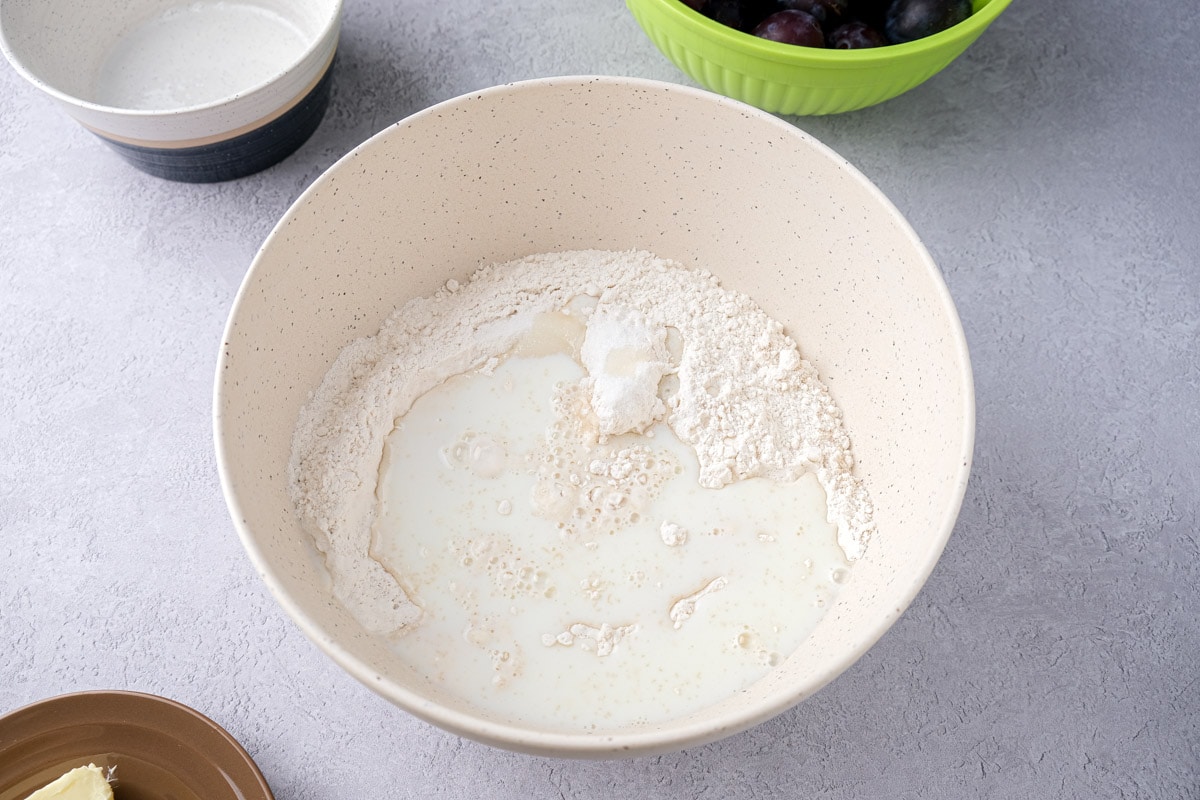
Next, add the sugar, salt, and warm milk.
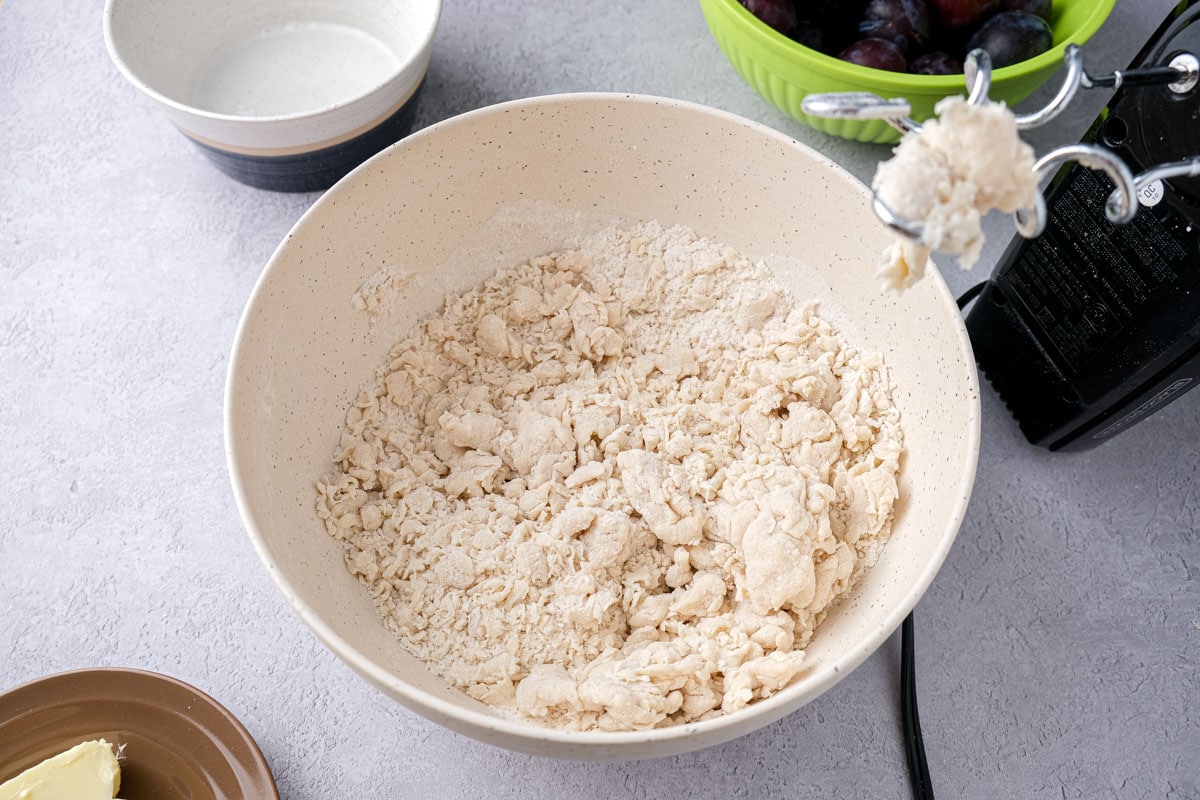
Use a hand or stand mixer with the spiral dough hooks to knead everything together until well combined.
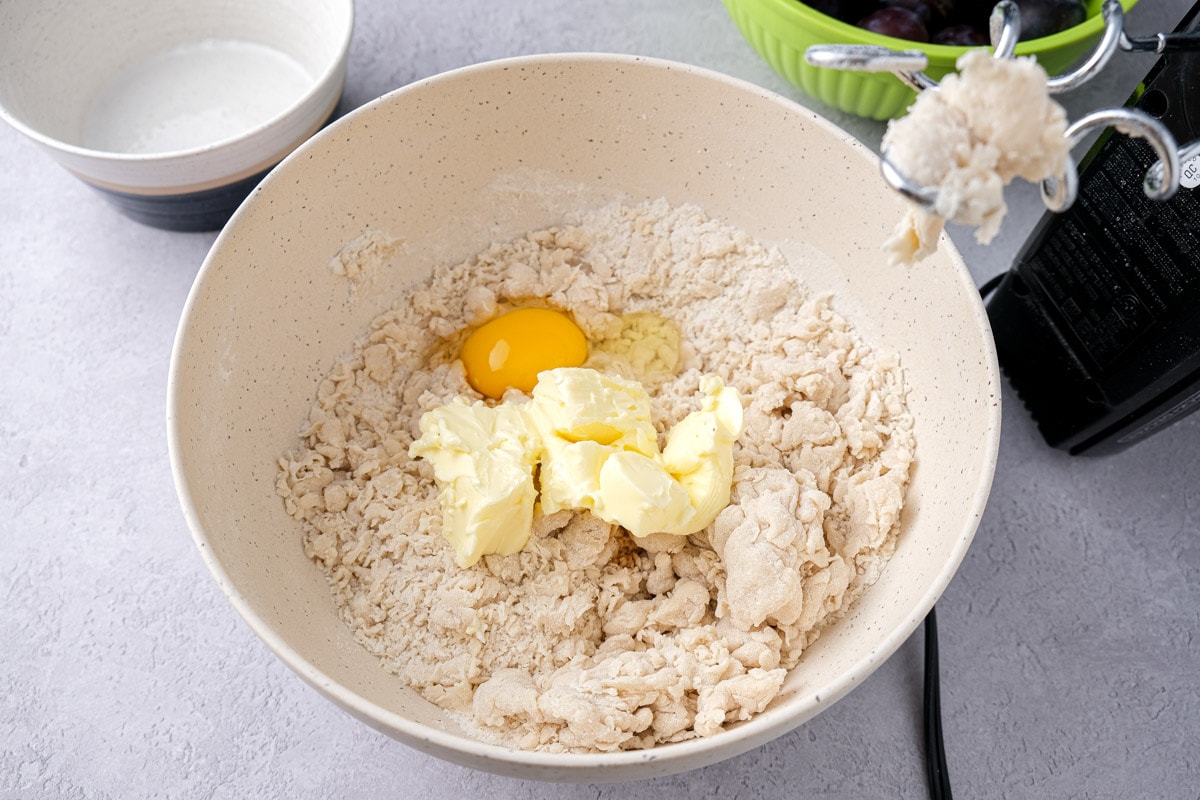
Add the vanilla extract, soft butter, and egg to the bowl.
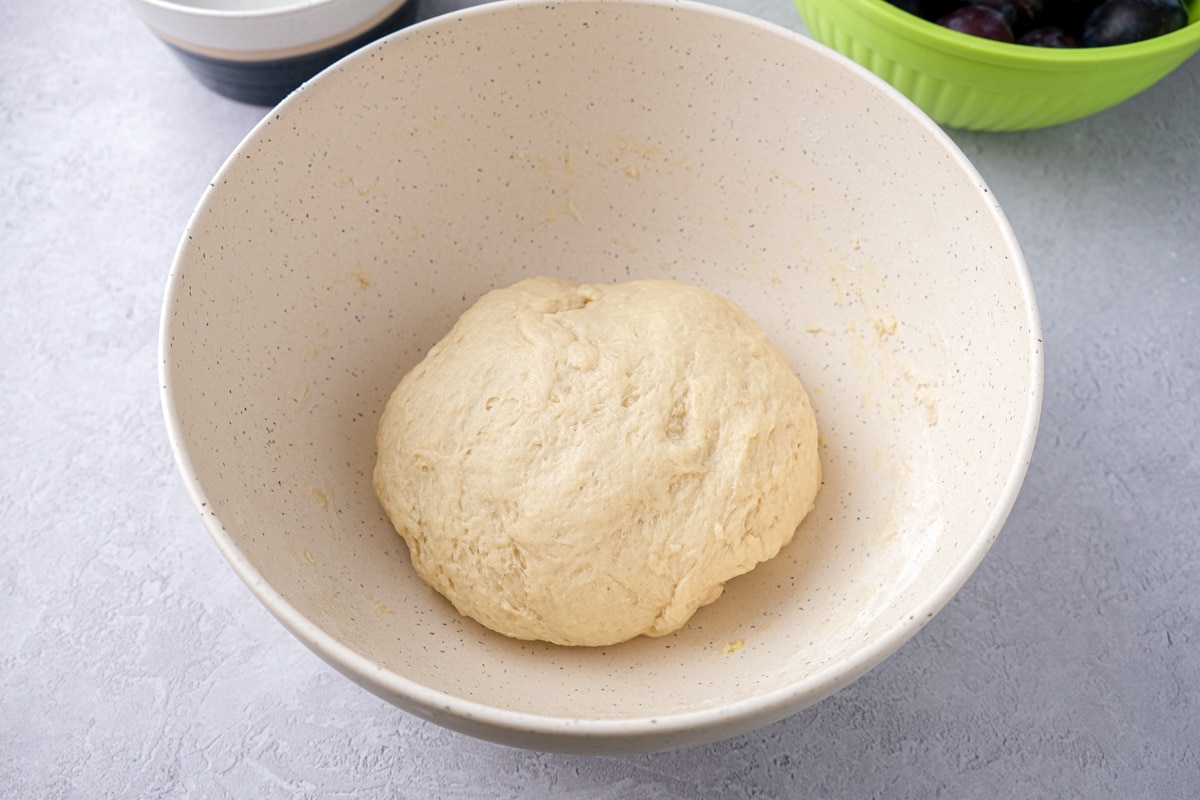
Knead for another 5 minutes until the dough is smooth and elastic.
If it sticks to your hands or the sides of the bowl, add a little bit more flour. If it is too dry and crumbly, add more milk.
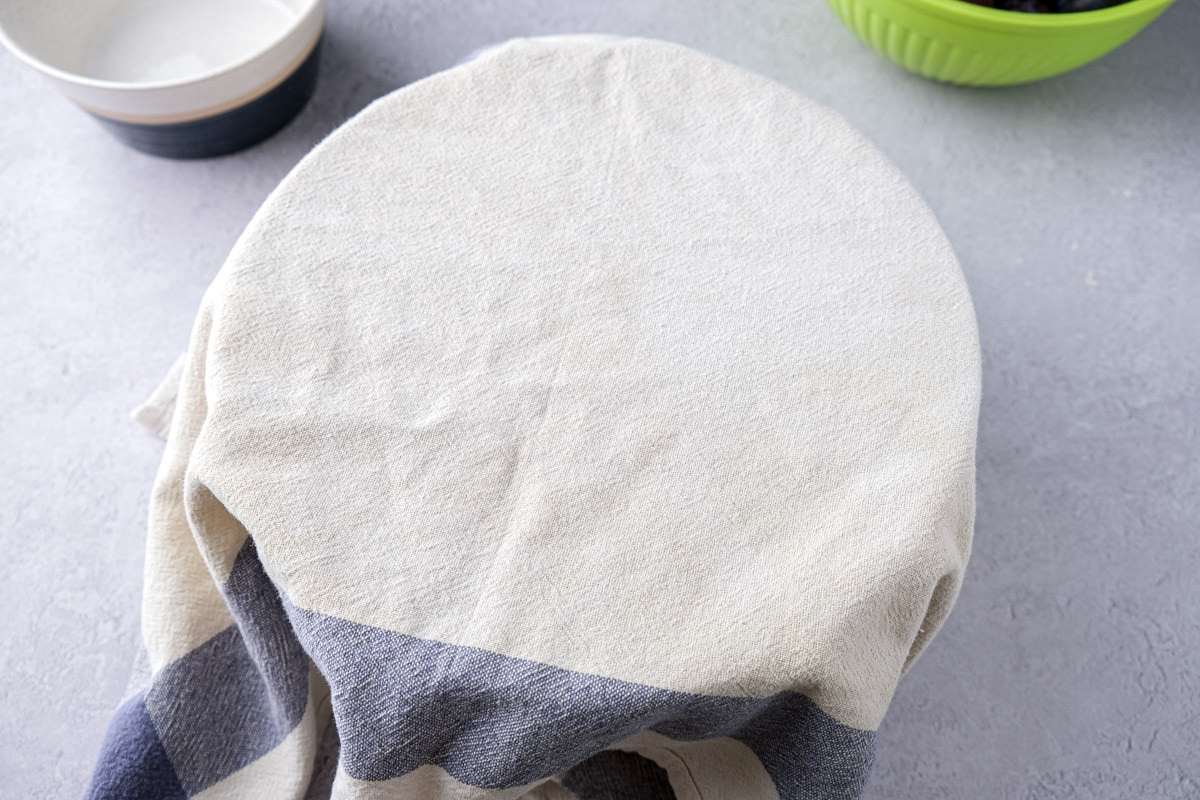
Cover the bowl with a dishtowel or a lid and place it in a warm, draft-free place. Let it rise for about an hour or until the dough has roughly doubled in size.
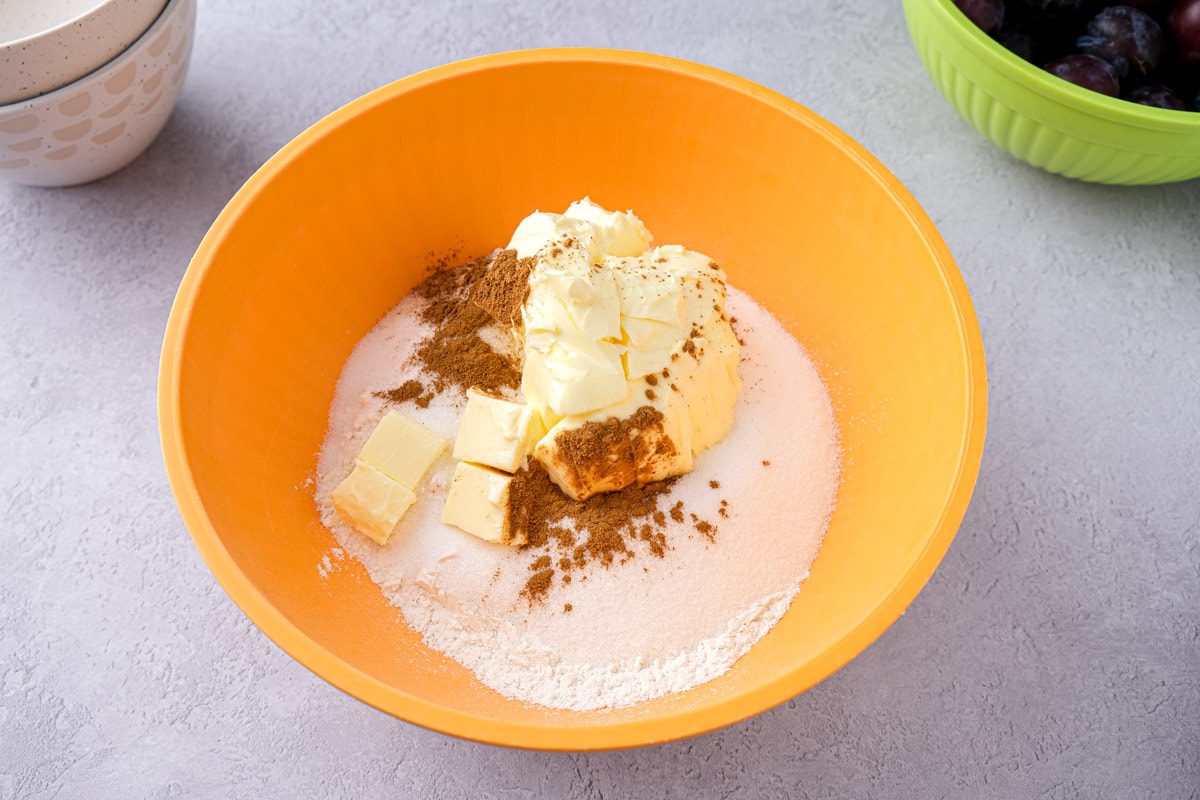
While the dough is rising, make the streusel topping. Add flour, butter, sugar, and ground cinnamon (optional) to a mixing bowl.
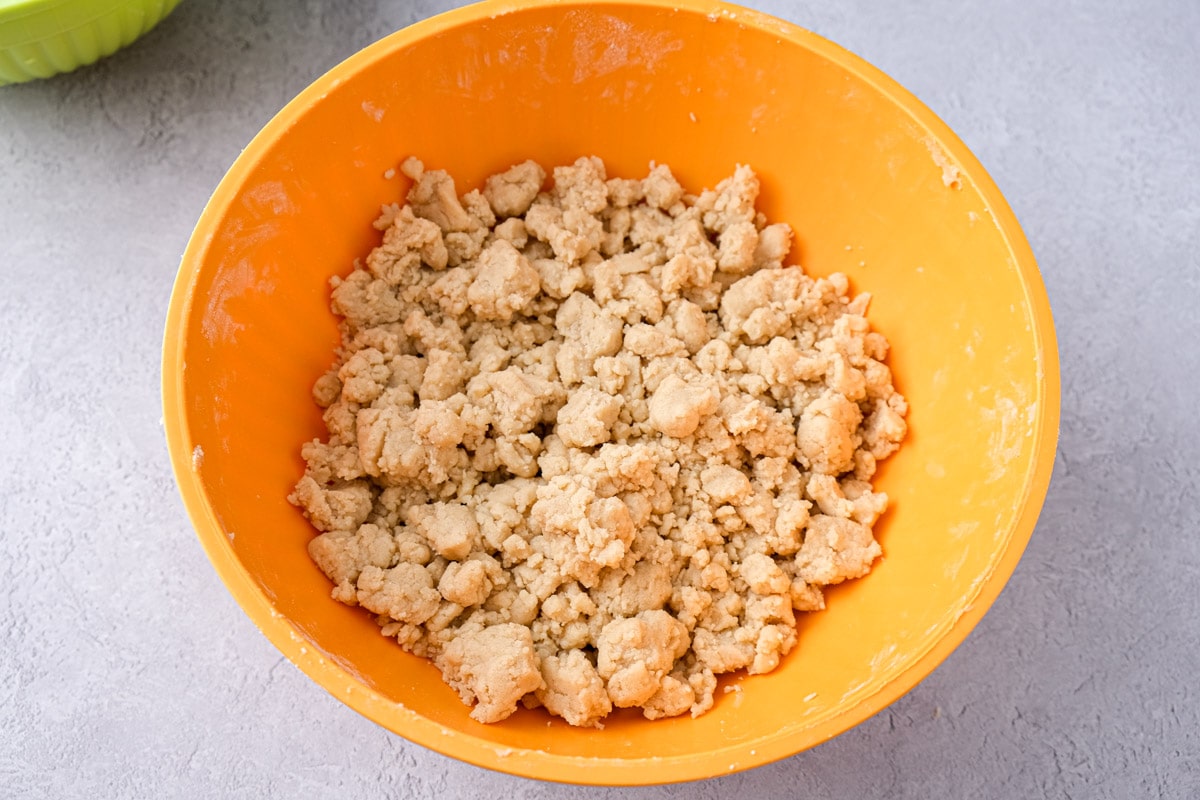
Knead with your clean hands until crumbly and no flour spots are visible. You can press them together lightly to make larger streusel. Set aside.
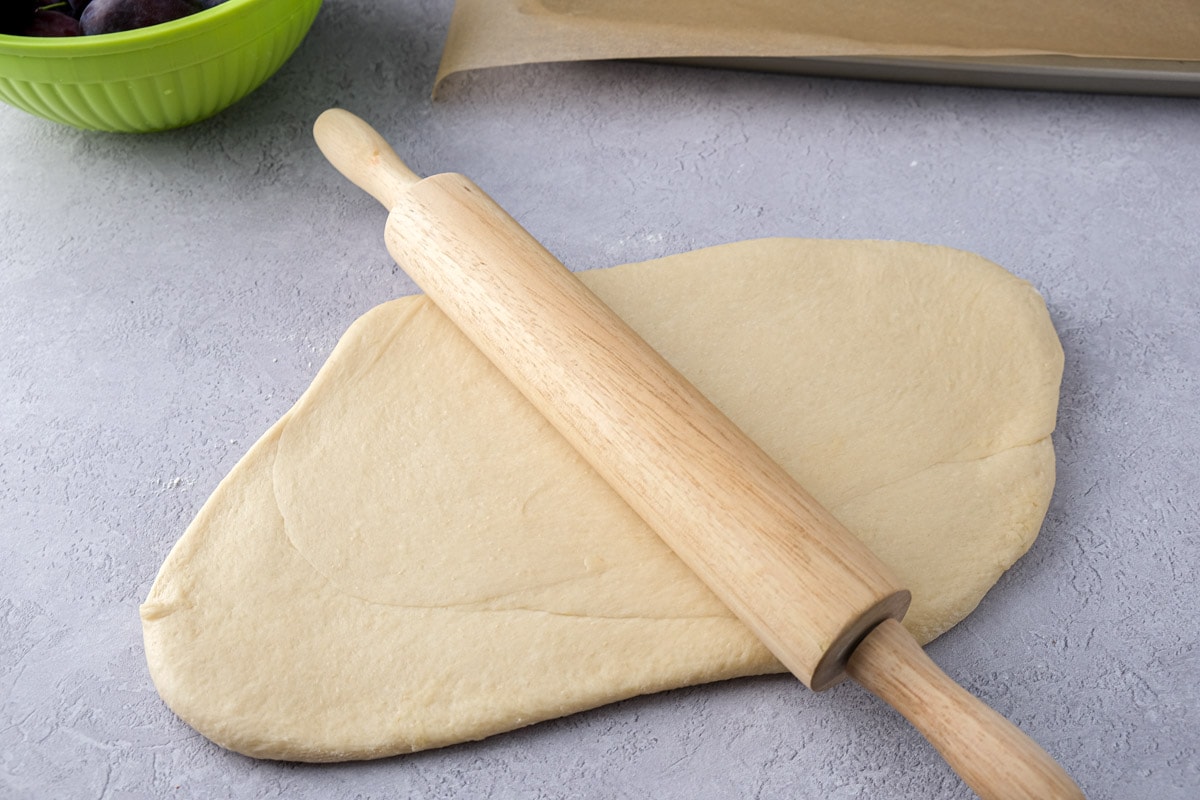
Line a 17×11 inch baking sheet (or slightly smaller) with parchment paper.
When the dough is done rising, sprinkle a little flour on your work surface and briefly knead the dough.
Then gently (!) roll it out with a rolling pin to fit your baking sheet – if it’s a little smaller, that’s fine.
If the dough wants to shrink back a lot, just let it sit for a few minutes, then try rolling it out again.
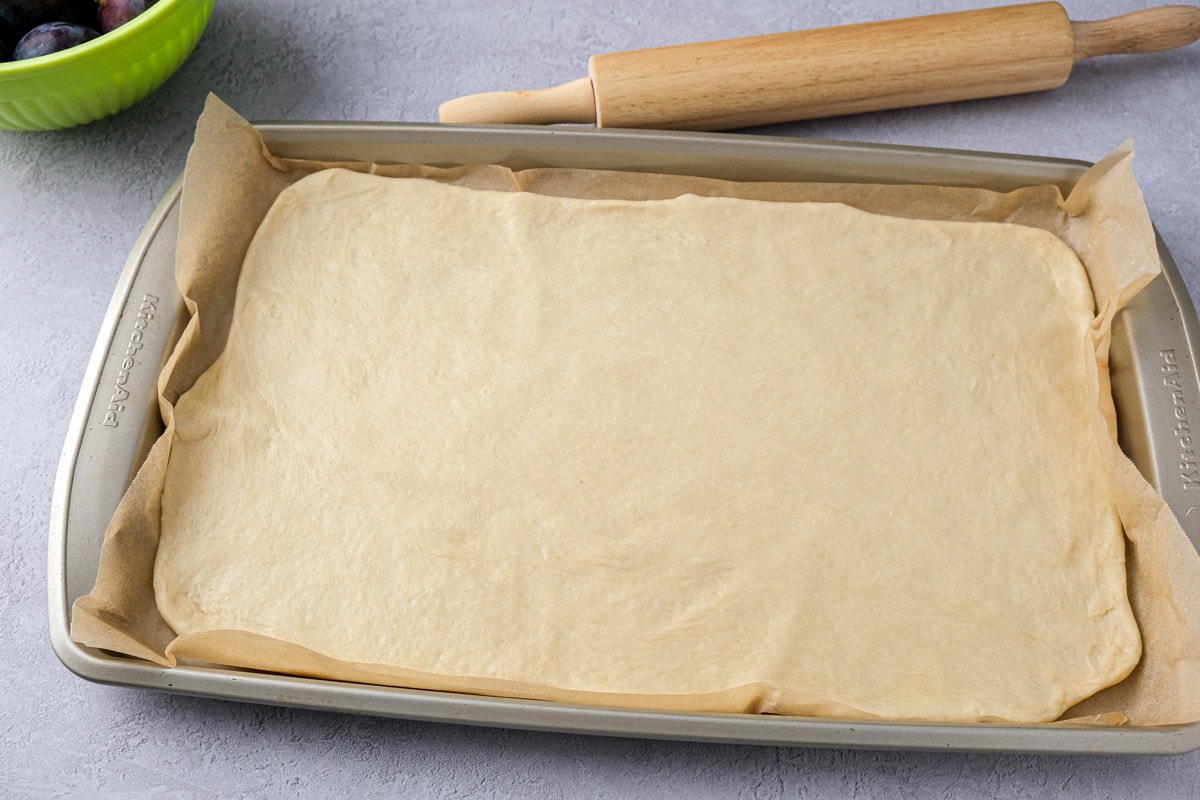
Place it on the prepared baking sheet and let it rise for another 15 minutes.
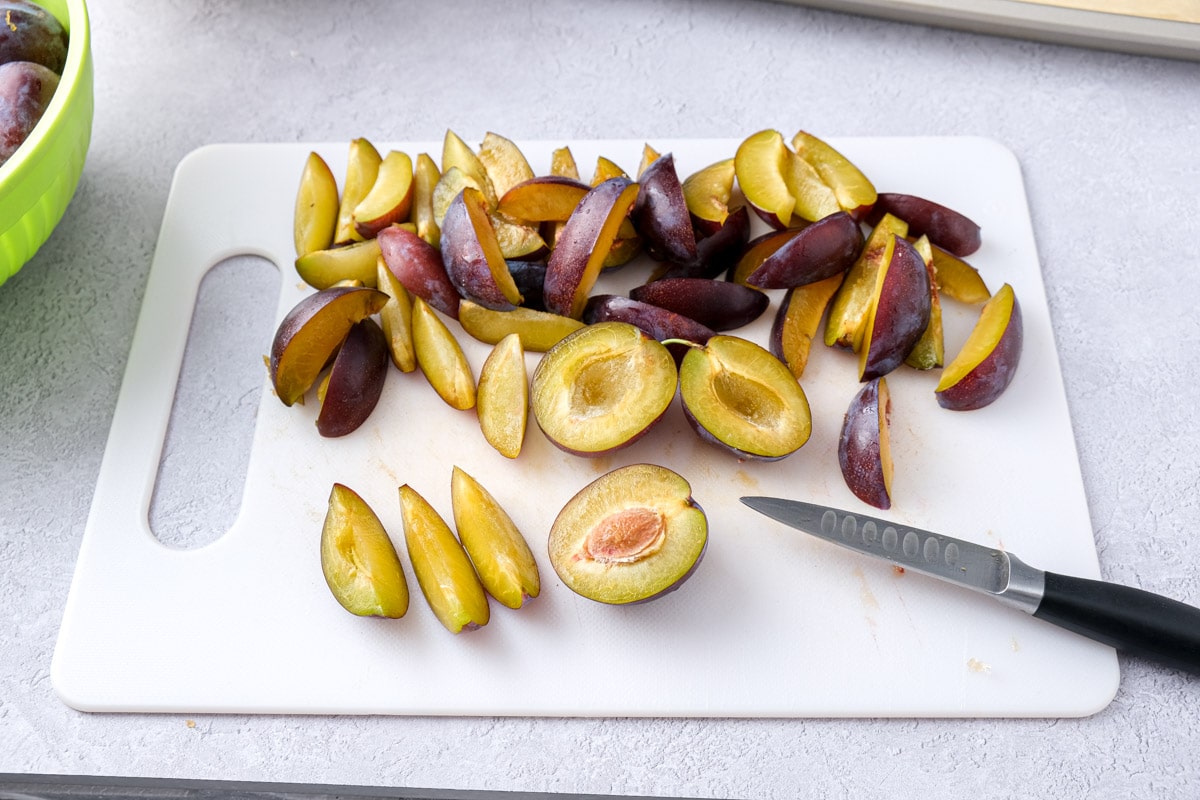
In the meantime, wash the plums and cut them in half to remove the stone. Then cut each half into 2-4 slices.
At this time also preheat the oven to 350 degrees Fahrenheit.
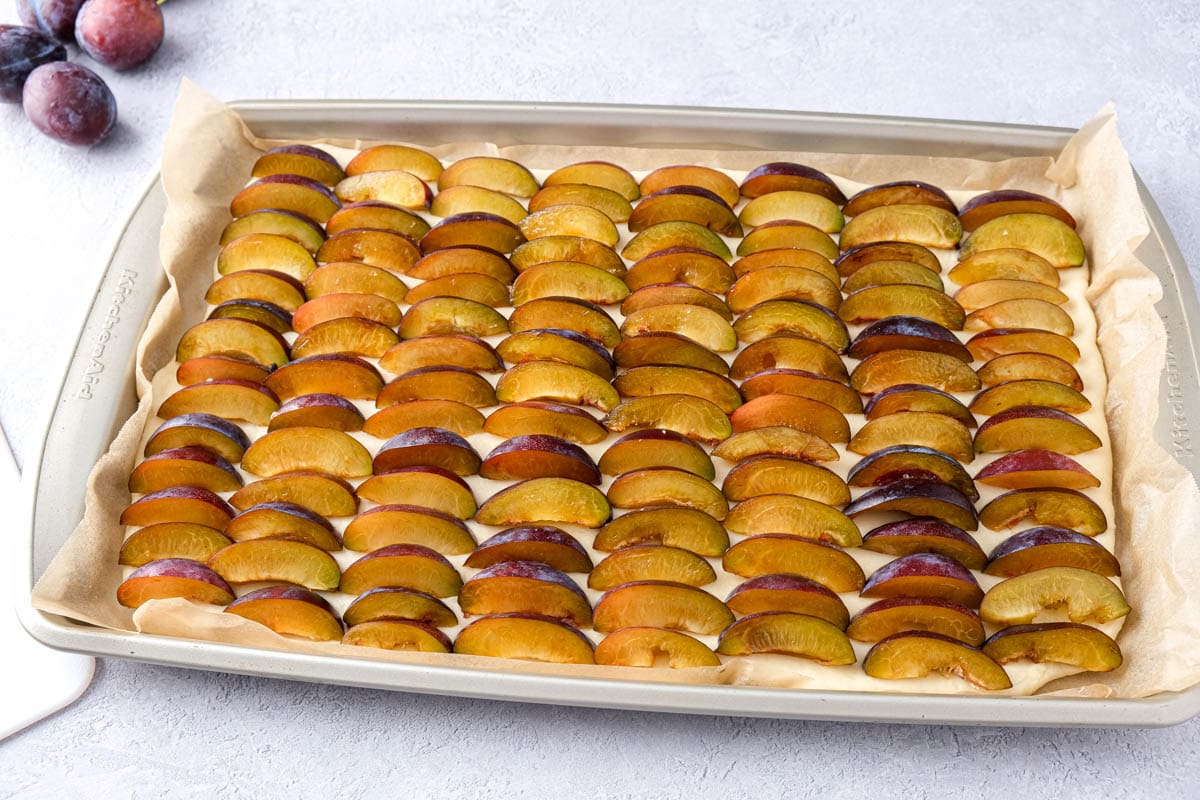
When the dough is done proofing a second time, place the plums in rows on top of the cake. You can overlap them slightly if you like.
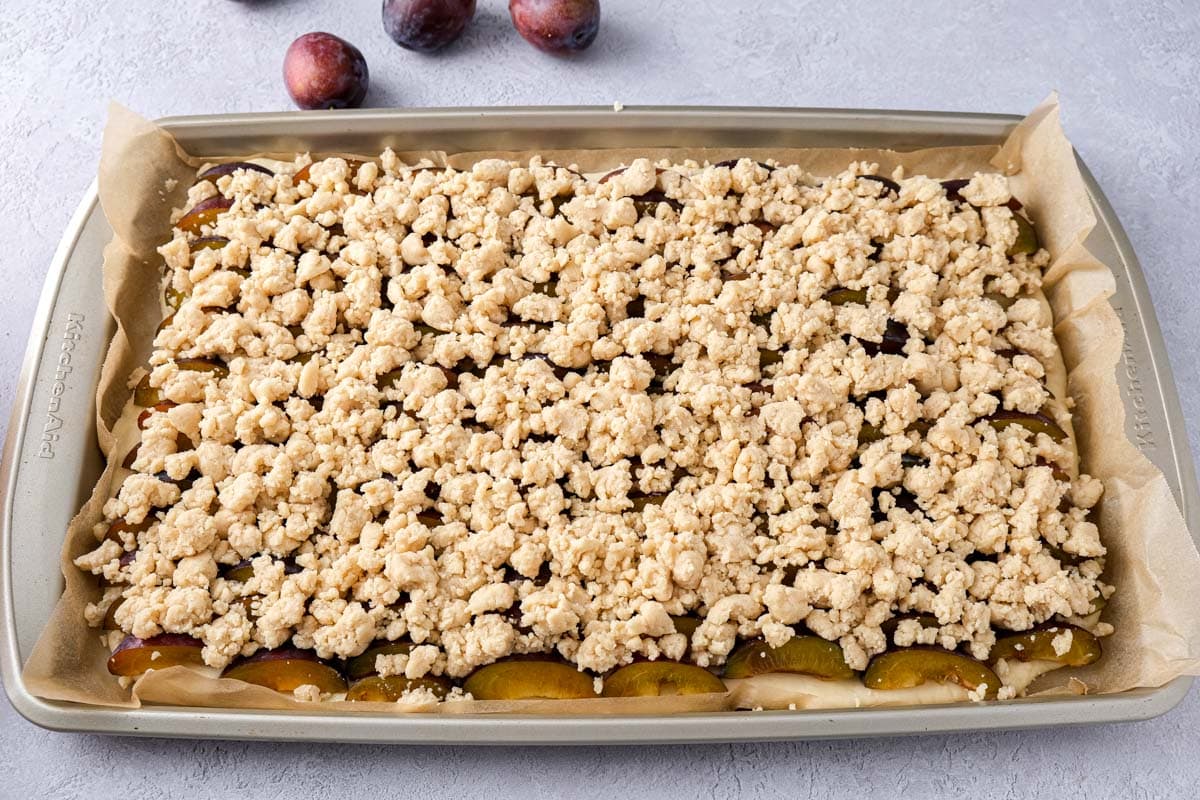
Sprinkle the streusel over the plums and bake at 350 degrees Fahrenheit for about 30 minutes or until a toothpick inserted comes out clean.
The exact baking time may vary depending on your oven.
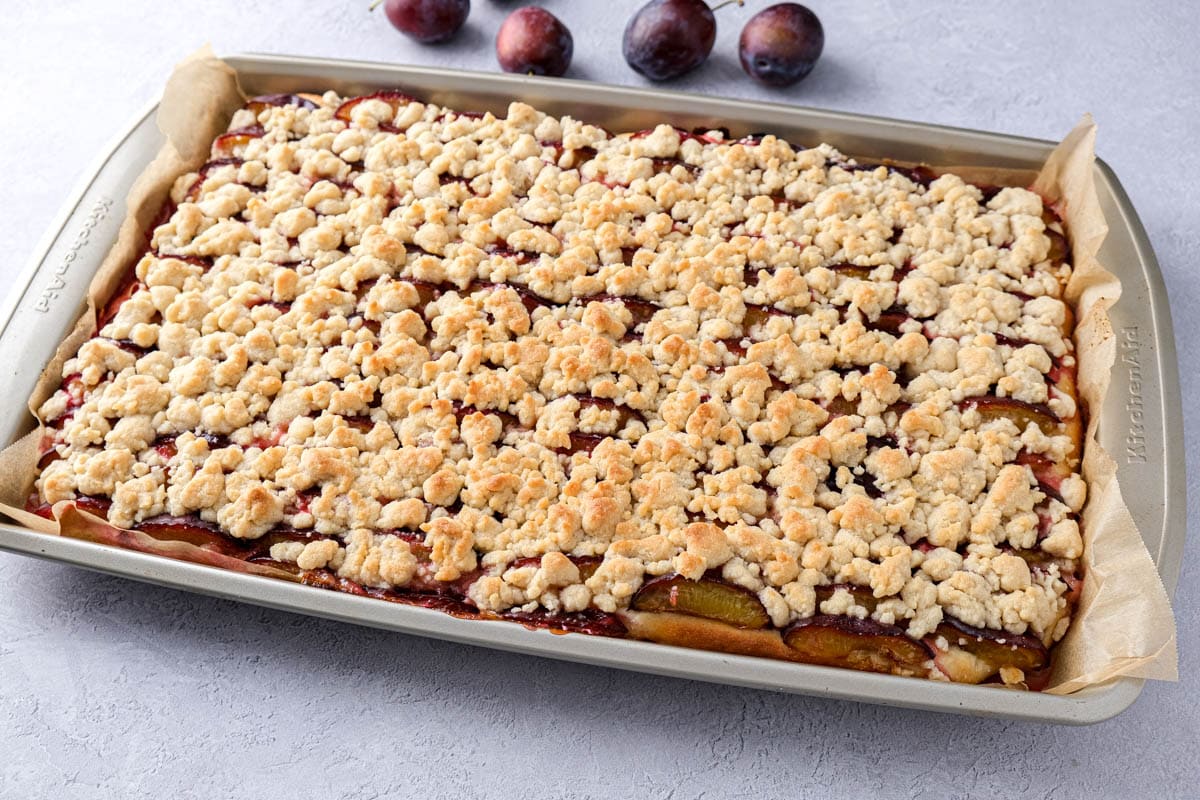
Allow the baked plum cake to cool slightly before cutting it into pieces.
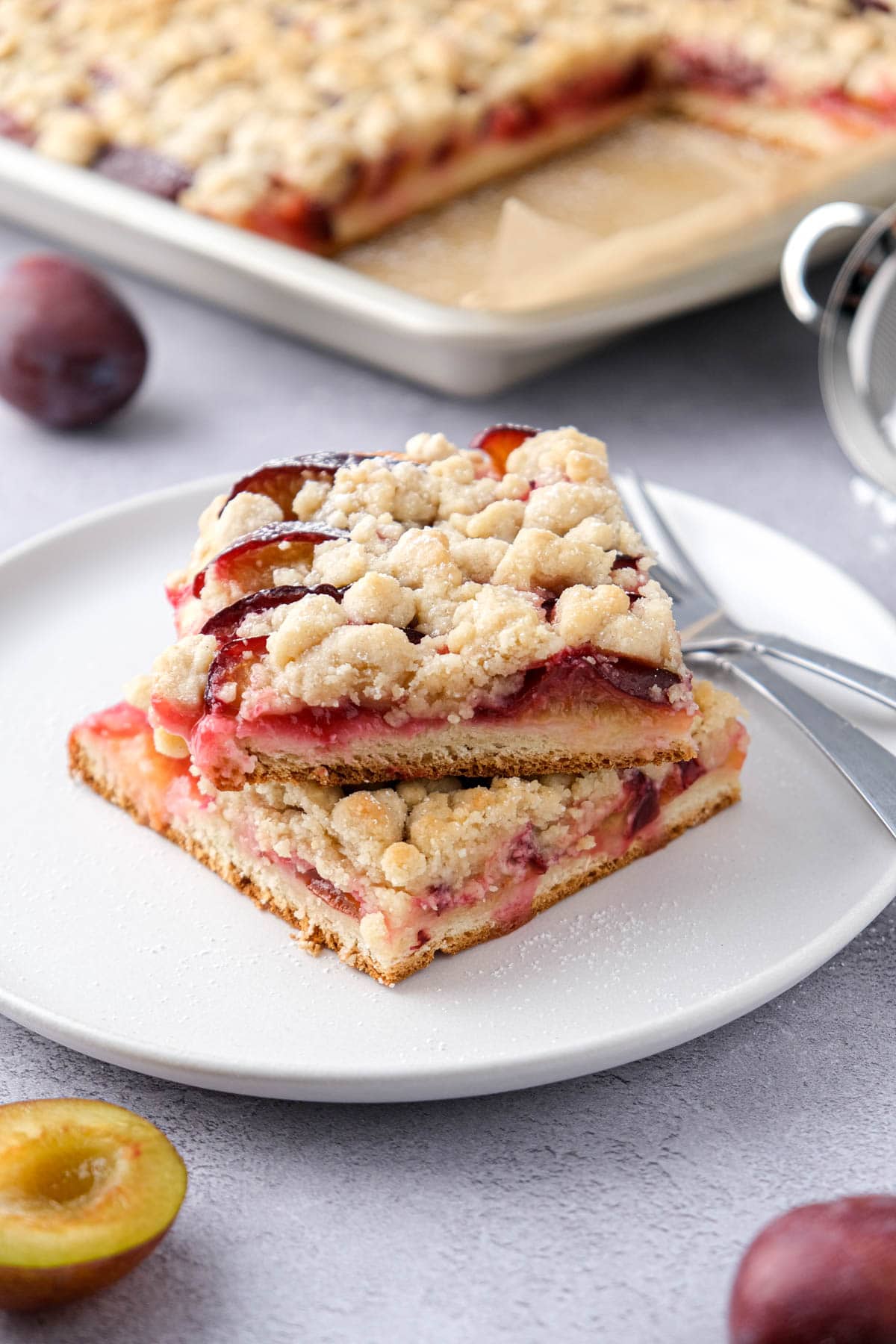
You can sprinkle the cake with powdered sugar before serving if desired. Enjoy!
Storage Tips
This plum cake definitely tastes best when it’s fresh, so we don’t recommend making it ahead of time.
If you have leftovers, you can store them in a sealed container at room temperature for 1 day or in the fridge for about 3 days. Keep in mind, however, that they likely won’t taste as good as when the cake is fresh.
In our opinion, the best way to store leftover plum cake is to cut it into slices and freeze it in freezer bags or containers. Properly stored, they’ll keep for about 3 months.
Just take a piece out and let it thaw in the fridge or at room temperature. You can even place it in the oven for a couple of minutes if you want to warm it up a bit.
Related Recipes
If you liked this recipe for German plum cake, here are some other classic German cakes that you may enjoy:
- Vanilla Pudding Cake
- Classic Streuselkuchen
- Erdbeerkuchen (Strawberry cake)
- Kalter Hund (No-Bake Chocolate Cake)
- Mohnkuchen (German Poppy Seed Cake)
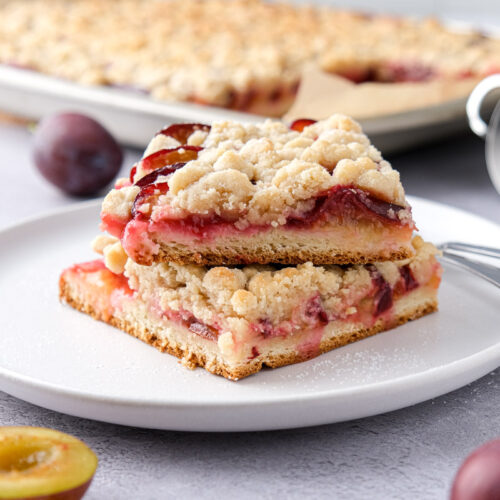
German Plum Cake (Pflaumenkuchen)
Ingredients
The Cake
- 3 cups all-purpose flour
- 2 1/4 teaspoons instant yeast
- 1/3 cup granulated sugar
- 1/8 teaspoon salt
- 3/4 cup milk, warm
- 1 teaspoon vanilla extract
- 1/3 cup butter, unsalted; at room temperature
- 1 large egg, at room temperature
- 2 1/2 pounds plums, approximately; preferably Italian prune plums/blue plums
The Streusel Topping
- 2 1/3 cups all-purpose flour, approximately
- 1 cup butter, unsalted; at room temperature
- 3/4 cup granulated sugar
- 1/2 – 1 teaspoon ground cinnamon, optional
Instructions
- In a large mixing bowl, whisk together the flour and instant dry yeast (check the package to make sure the yeast doesn't need to be dissolved first).3 cups all-purpose flour, 2 1/4 teaspoons instant yeast
- Add the sugar, salt, and warm milk. Use a hand or stand mixer with spiral dough hooks to knead everything together until well combined.1/3 cup granulated sugar, 1/8 teaspoon salt, 3/4 cup milk
- Add the vanilla extract, soft butter, and egg to the bowl. Knead for another 5 minutes until the dough is smooth and elastic. If it sticks to your hands or the sides of the bowl, add a little bit more flour. If it is too dry and crumbly, add more milk.1 teaspoon vanilla extract, 1/3 cup butter, 1 large egg
- Cover the bowl with a towel or a lid and place it in a warm, draft-free place. Let it rise for about an hour or until the dough has roughly doubled in size.
- While the dough is rising, make the streusel topping. Add flour, butter, sugar, and ground cinnamon (optional) to a mixing bowl. Knead with your clean hands until crumbly and no flour spots are visible. You can press them together lightly to make larger streusel. Set aside.1 cup butter, 3/4 cup granulated sugar, 2 1/3 cups all-purpose flour, 1/2 – 1 teaspoon ground cinnamon
- Line a 17×11-inch baking sheet (or slightly smaller) with parchment paper.
- When the dough is done rising, sprinkle a little flour on your work surface and briefly knead the dough. Then gently (!) roll it out with a rolling pin to fit your baking sheet. Place it on the prepared baking sheet and let it rise for another 15 minutes.
- Meanwhile, wash the plums and cut them in half to remove the stone. Then cut each half into 2-4 slices. Also preheat the oven to 350 degrees Fahrenheit.2 1/2 pounds plums
- Arrange the plums in rows on top of the cake. You can overlap them slightly if you like.
- Sprinkle the streusel over the plums and bake at 350 degrees Fahrenheit for about 30 minutes or until a toothpick inserted comes out clean. The exact baking time may vary depending on your oven.
- Allow the plum cake to cool slightly before cutting it into slices. You can sprinkle the cake with powdered sugar before serving if desired.
Notes
- Any type of plum will work, but traditionally this cake is made with Italian prune plums, also called blue plums.
- Use plums that are ripe but not too soft. If the plums you’re using are very juicy, you can sprinkle some unseasoned breadcrumbs on the rolled-out dough before placing the plums on top.
- You can also make this cake with other stone fruits, such as peaches, nectarines, or apricots.
- Make sure the yeast you’re using hasn’t expired.
- Since we’re using yeast, it’s important that the egg and butter are at room temperature. The milk needs to be warm, but not hot.
Nutrition
This nutritional information has been estimated by an online nutrition calculator. It should only be seen as a rough calculation and not a replacement for professional dietary advice.

This is the recipe I remember my Mutti making!! Thank you
My German mother in law used unsalted butter for the streusel plus Dr. Oetker’s vanilla sugar that adds a good taste. I bake mine in a jellyroll pan and use BC prune plums or apples or rhubarb. Prune plums and rhubarb are my favourites.
Thanks for sharing Lorna, the combination with prune plums and rhubarb sounds really good! I also always use unsalted butter for making this cake – I should probably add a note for that, thanks! /Lisa
I’m not a very good Cook! and I don’t eat cakes because of the sugar content, but I love chicken & would appreciate a genuine Hungarian chicken paprika to cook with Chicken thighs!!!
I would really appreciate that, as a Hungarian chap used to cook it for me but I can’t remember the ingredients?
I hope you can help me?
Lesley Line
Hi Lesley, we have a chicken paprikash recipe with chicken thighs here: https://www.recipesfromeurope.com/hungarian-chicken-paprikash/ I hope it comes close to what you remember! /Lisa